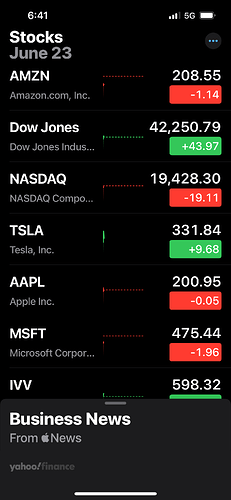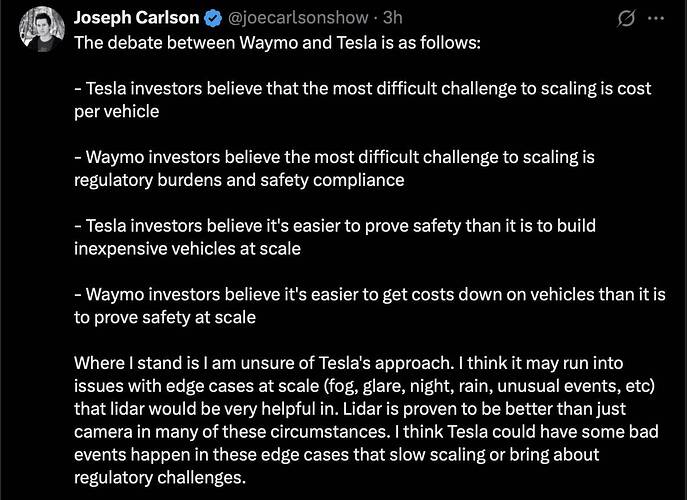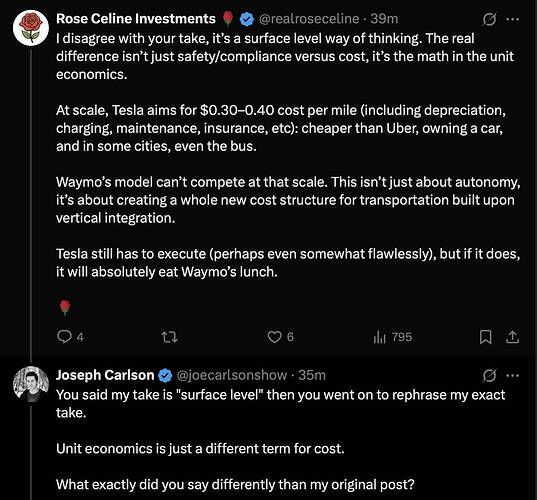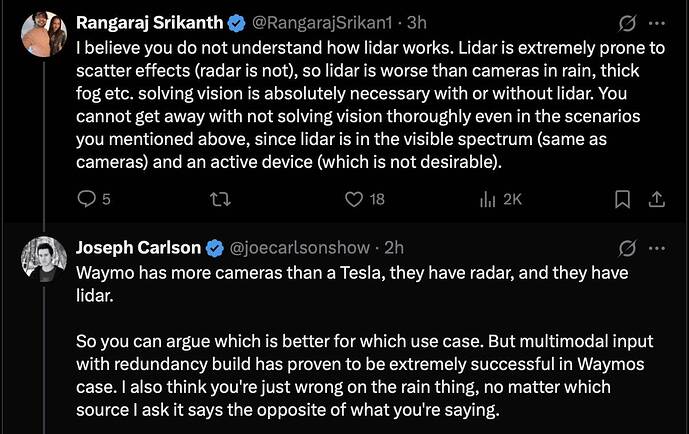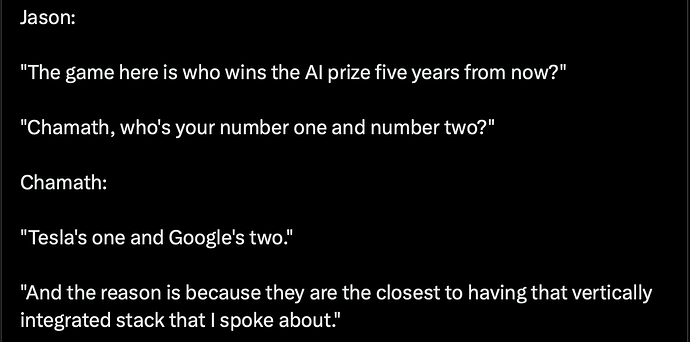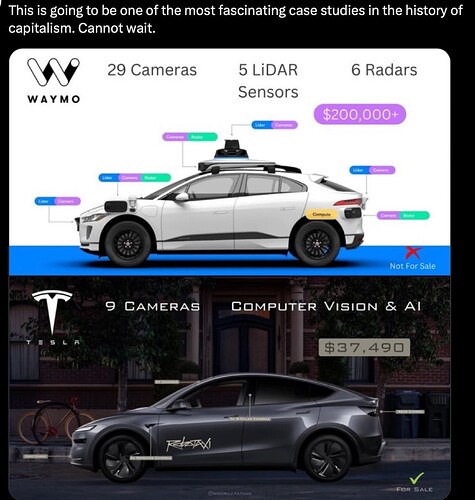I will run for mayor for the City of Palo Alto under the American Party. I feel that I fit this role perfectly ![]()
Trouble is, no one is in agreement on what constitutes “the middle.”
Everyone has a different idea.
CEO, Musk would spend years working first to prove that there was demand for electric cars and then racing to scale production. More recently, he has become narrowly focused on the robotics vision for the business—driverless cars and humanoid robots.
The market seems neutral to the Iranian bombing.
Can Trump pull this mess out of a hat?
Are the Iranians just blowing smoke?
Is China just a paper tiger?
Looks like Putin doesn’t care about Iran. Or anyone else for that matter.
The entire geopolitical balance of power has been significantly shifted in Israel’s favor after the Hamas attack. Syria had a regime change. Hamas is mostly wiped out. And now Iran has been neutered.
All these dictatorship regimes like Iran, North Korea and Russia are garbage. They looked strong against their own powerless people. But they are chicken shit compared to democratic powers like Israel and the US.
I would put China in the same garbage bin as Iran. It looks strong but in reality just a paper tiger.
I still think we will see a new all time high in stocks and cryptos in the next month or two, before effects of Trump’s braindead economic policies finally sink in.
Tesla only had 20 or so robotaxis in a tiny area of Austin, with a Tesla employee sitting on the passenger seat. That person had their thumb on a kill switch at all time. The rollout was only to a pre-selected group of Tesla influencers doing free promotion for Tesla, not real customers.
I don’t know how people can compare that with real operation on the Waymo side. Just today Waymo expanded to Atlanta.
Capability-wise, Waymo is way ahead of Tesla. It’s premature to compare unit costs at this stage because Waymo is offering robotaxi for real at a big scale, and Tesla just driving its fans around with a dude sitting in front. If and when Tesla’s tech reaches parity with Waymo, only then can we compare costs. A bicycle is obviously cheaper than a car, not a meaningful comparison.
Elon’s stubborn adhesion to vision only approach is keeping Waymo, Zoox and all the other self-driving players alive. If Elon had adopted lidar, he can quickly drive down the its cost. Elon is an operational genius. If Elon did the same tech stack as Waymo, I am pretty sure he can get costs down to 1/2 or even 1/3 of what Waymo is paying. But instead he chose to tackle a much harder problem.
Tesla’s robotaxi rollout will be painfully slow. Fanboys had their hopes up too high.
I think robotaxi is a good thing for Tesla. It forces Tesla to either advance its models very quickly or face the reality that it needs something else like a lidar to become better then act on it. The service has just been rolled out so I’d imagine it’s going to take some time to settle by which time we will see whether there is hope for this or not. It’s too early to tell at the moment.
I am curious to know how much computing power Waymo is packing in its cars. I think Tesla should already know that, so it should know whether its current hardware (HW4) is sufficient in terms of computing power. Maybe Tesla already knows that it’s not and it just won’t tell us so that we keep buying cars with current hardware while they develop the next platform.
On the other hand I don’t think Tesla has run out of bugs to fix from test cases. Personally I have filed a test case that the current FSD version fail most of the time (intersection of Arastradero and Foothill). So it’s not like Tesla needs the robotaxi service to produce test cases to fix. The bottleneck should already be on the bug-fixing side, not bug generation. Or maybe my bug is actually a bug with Google maps but Google may be incentivized to not fix it quickly in order to slow Tesla down. Who knows.
I think relying on vision only is a much harder problem to solve, than having many different types of sensors to compliment each other that gets a fuller understanding of the surrounding. Even humans don’t just rely on vision. We won’t know a firetruck is coming if we don’t hear sound.
Some FSD users have complained sun ray hitting at a certain angle confuses the FSD AI model. Even the tiny rollout on Sunday ran into that issue. What if the weather is bad like rain and snow? It gets tricky.
Robotaxi is a solved problem. Waymo is doing 250K paid rides a week and is fast expanding. Robotaxi using Tesla’s unique approach is something else though. Can it reach the level of safety and reliability a commercial taxi service requires? Nobody knows. I think it can get there, eventually. But it will take much longer than people expect.
I agree that it will take a long time to get there, if it can get there eventually with the current vision-only approach. Nobody knows at this point, but this robotaxi service launch is going to accelerate the process of finding out whether it can work or not.
Also robotaxi is a solved problem in the sense that it seems solved in Waymo’s way, which needs careful mapping of everything. I once heard from someone I met that the self-driving solutions in China are similar in that they need to run cars to collect the latest mapping data every single day so that the self-driving cars can have accurate landscape to rely on. In this sense the US is much better with very little construction going on (you collect once and it’s good for 50 years ![]() ).
).
Tesla is trying to solve it in a more generalized way, which by definition is going to be much harder. It’s possible that through the robotaxi exercise Tesla will realize the problem space is too large to solve in a meaningful pace that puts itself at a disadvantage then adjust its strategy.
Either way robotaxi is forcing Tesla to face reality quicker on FSD.
.
I don’t see the point of this approach if robotaxi is intended on man-made roads. However, if it is intended to travel on mountain treks, rural area and on moon eventually, ok.
Waymo’s reliance on HD map is overblown. It’s mostly a one time cost pre-launch. After launch its fleet vehicles will do the scanning and updating continuously.
From ChatGPT:
 How Waymo Keeps Its Maps Current
How Waymo Keeps Its Maps Current
1. Drive-to-detect Updates
Every Waymo vehicle is constantly scanning its environment with LiDAR, cameras, and radar. When it detects a change—like new construction, altered road markings, or relocated street signs—it flags the discrepancy and sends the data back to Waymo’s operations team arxiv.org+15waymo.com+15reddit.com+15.
2. Automated Re-Mapping
That vehicle-sourced change data is then processed and validated, with updates made in the central HD map database. These updates are quickly pushed out so the entire fleet stays aligned with the real world .
3. Continuous, Fleet-Wide Rollout
Updates aren’t batch-processed monthly—they’re effectively rolled out in near real-time. This means stagnant HD maps are rare—even dynamic cities are mapped accurately thanks to the active fleet
Prior to Tesla’s robotaxi event last Sunday, many people reported seeing Tesla test vehicles roaming the streets of Austin. It seems Tesla also needs to do a lot of prep work to “map out” its service area. We don’t know what Tesla was doing. It may not be in the form of a literal map. They won’t say. But I think Tesla’s vision-only approach is not really all that general compared to Waymo’s. It also needs to do tons of prep work.
I think FSD has reached somewhere like 98% reliability. It works well as a driving aid, but not yet reliable enough for a taxi that’s constantly on the road day and night year round. At 99.99% reliability a robotaxi would still have around 5 accidents a year. We will need somewhere close to 99.9999% reliability. It will take a while for Tesla to get there. And the final form of hardware that enables it may not even be cheaper. Tesla may need more compute on its cars and central servers to do things in software that Waymo does in hardware.
No law states that robotaxis need to be 99.9999% reliable to operate. Waymo doesn’t have 99.9999% reliability. I’ve seen it driving on the wrong side of the road. I don’t mind it having that kind of reliability though, because I do own lots of Google stocks.
Whether Waymo is better than Tesla is debatable, but let’s assume it is. Tesla doesn’t need to be as good as Waymo. It only costs a fraction of Waymo’s cost. Most people would rather drive a cheap Toyota Corolla than an expensive Rolls Royce. Because they can’t afford it. Yes, Tesla’s the Corolla and Waymo is the Rolls Royce. Toyota has a much higher market cap than Rolls Royce.
Holding 100 shares of TSLA is kind of useless. Although it’s still better than holding nothing like some people, I must say ![]()
From ChatGPT:
| System | Miles per Disengagement |
|---|---|
| Tesla FSD v13.2.9 | ~371 miles |
| Waymo | ~17,000 miles |
Waymo is currently ~50X safer than Tesla FSD. People in SF willingly pay extra over Uber to ride in Waymo. My kids sometimes ride Waymo by themselves to schools. I’d gladly pay extra for safety.
Tesla needs to be above certain safety threshold to be a viable option. It currently is not there yet. Maybe it will eventually? I think we can only compare costs after Tesla reaches feature parity. What’s your bet on when Tesla doesn’t require a dude sitting in front holding a kill switch? 3 months? 1 year? 3 years?
And even if robotaxis doesn’t pan out, there’s still Optimus. TSLA has always been a hopium stock. We have enough substance as is, so it’s not necessarily going to crash to $125 per share as someone might have hoped ![]()
